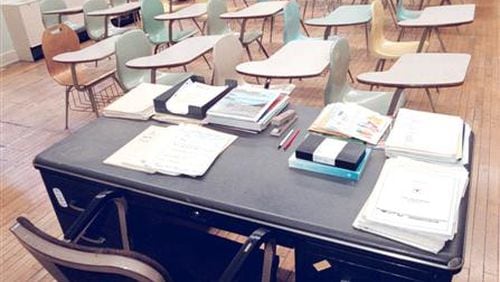I am not sure parents pay attention to the release of the National Assessment of Educational Progress, better known as the Nation’s Report Card, but education advocacy groups do.
And the general response to today’s stagnant math and reading scores from the 2017 administration of NAEP was the usual vow we must do better.
But the question remains how to do so, especially for children at the lowest end of the achievement spectrum.
NAEP is a nationally representative and continuing assessment of what America’s students know and can do in various subject areas. The test is administered every two years to a sample of fourth and eighth graders, from a sample of schools across each state.
Overall, these latest NAEP results show a dispiriting trend already pointed out by researchers: America’s top students continue to show improvement, but kids at the lower scoring levels are losing ground.
(NAEP findings reflect national research that shows higher-income kids in America are increasingly outperforming peers from middle and lower-income households. Stanford's Sean F. Reardon has studied the relationship between academic achievement and family income over the last 50 years. He found an increased link between family income and children's academic achievement for families above the median income level, writing, "A given difference in family incomes now corresponds to a 30 to 60 percent larger difference in achievement than it did for children born in the 1970s.")
Between January and March of last year, NAEP was given to 300,000 fourth graders and nearly 290,000 eighth graders. Student performance is reported in scores from zero to 500 and then categorized in three achievement levels, basic, proficient and advanced. Proficient indicates mastery and is not an easy level to attain.
The 2017 test marked a move from pencil and paper to computer tablet assessments in fourth and eighth grade math and reading. Students analyzed color maps charts and photographs. They had interactive graphs and audio.
At a media event streamlined online this morning, Peggy Carr, acting commissioner of the National Center for Education Statistics, talked about the progress of American students:
Fourth grade math: Students improved 27 points since the first comparison NAEP test in 1990. But, overall, there was no significant change since the test was last given in 2015. However, the lowest performing students dropped slightly.
Eighth grade math: Students improved 20 points since 1990. However, there was little change over the last two years. Highest-performing students improved since 2015, but lowest-performing students faltered.
Fourth grade reading: Students improved 5 points since the first comparison test year in 1992. But there was little change since 2015. Since 2015, there were declines in lowest-performing students.
Eighth grade reading: Students improved seven points since 1992. There was overall improvement compared to 2015, especially in the higher-scoring echelon.
Overall patterns: Lowest-performing students in grade 4 had score declines. Meanwhile, higher performing students in grade 8 showed improved from 2015 to 2017 in both reading and math. In eighth grade reading, there was bifurcation of scores with high performing students improving.
Gaps: The gaps remain largely the same. Where there was change in math, the gaps widened.
Here are some of the reactions to the new NAEP scores from education advocates:
“Teachers and administrators need robust support to implement higher standards; there must be a substantial, ongoing effort to continuously improve the quality of curriculum and the capacity of schools -- particularly those serving the most disadvantaged students -- to ensure that kids can meet the higher standards that states have set and that the real world demands,” said Michael Cohen, president of Achieve.
U.S. Education Secretary Betsy DeVos said, “Our nation’s reading and math scores continue to stagnate. More alarmingly, the gap between the highest and lowest performing students is widening, despite billions in Federal funding designated specifically to help close it. One bright spot in today’s report is Florida, where Sunshine State students are bucking the national trend, showing significant improvement in 4th and 8th grade math and in 8th grade reading. Both low and high performers in Florida demonstrated that improvement, again bucking the national trend and narrowing the achievement gap.”
Patricia Levesque, CEO of the Foundation for Excellence in Education, said, “It is also clear that we need to do more for all students, especially those in traditionally underserved areas including minority and low-income families. A strong education that prepares students for success in school and in careers remains the best way to lift families and our nation toward success.”
Here is what Georgia DOE said:
The results show Georgia’s students improving in eighth grade reading and math, and holding steady in fourth grade math. There was a slight (two-point) decrease in fourth-grade reading. Georgia is above the national average in eighth-grade reading, and nearing the national average in the other three subject areas.
“I’m pleased to see Georgia’s students making gains in eighth-grade reading and math,” State School Superintendent Richard Woods said. “There is more work to be done, but as we continue our efforts to strengthen foundational instruction, provide developmentally appropriate formative assessments for early literacy and numeracy, and invest in reading and literacy, I’m confident we’ll see Georgia continuing to move in the right direction.”
Eighth Grade Math
Georgia’s eighth-grade students recorded an average scale score of 281 in math, compared to a national average of 282. Georgia eighth graders' average score in 2015 was 279.
The percentage of students in Georgia who performed at or above the NAEP Basic level was 68 percent in 2017, compared to a national average of 70 percent. 67 percent of Georgia students performed at or above the NAEP Basic level in 2015.
The percentage of Georgia students who performed at or above the NAEP Proficient level was 31 percent in 2017, compared to a national average of 34 percent. 28 percent of Georgia students performed at or above the NAEP Proficient level in 2015.
Eighth Grade Reading
In reading, Georgia’s eighth-grade students recorded an average scale score of 266, compared to a national average of 265. Georgia eight-graders’ average score in 2015 was 262.
The percentage of students in Georgia who performed at or above the NAEP Basic level was 76 percent in 2017, compared to a national average of 76 percent. 73 percent of Georgia students performed at or above the NAEP Basic level in 2015.
The percentage of Georgia students who performed at or above the NAEP Proficient level was 35 percent in 2017, compared to the national average of 36. 30 percent of Georgia students performed at or above the NAEP Proficient level in 2015.
Fourth Grade Math
Georgia’s fourth-grade students recorded an average scale score of 236 in math, compared to a national average of 239. There was no change from Georgia fourth-graders’ average score in 2015.
The percentage of students in Georgia who performed at or above the NAEP Basic level was 77 percent in 2017, compared to a national average of 79 percent. 78 percent of Georgia students performed at or above the NAEP Basic level in 2015.
The percentage of students in Georgia who performed at or above the NAEP Proficient level was 35 in 2017, compared to a national average of 40 percent. This was the same as the percentage in 2015.
Fourth Grade Reading
In reading, Georgia’s fourth-grade students recorded an average scale score of 220, compared to a national average of 221. Georgia fourth-graders’ average score was 222 in 2015.
The percentage of students in Georgia who performed at or above the NAEP Basic level was 66 percent in 2017, compared to a national average of 68 percent. 68 percent of Georgia students performed at or above the NAEP Basic level in 2015.
The percentage of students in Georgia who performed at or above the NAEP Proficient level was 35 percent in 2017, compared to a national average of 37 percent. 34 percent of Georgia students performed at or above the NAEP Proficient level in 2015.
In some areas, there was a significant decrease in the average scale score for students with disabilities. Improving outcomes and opportunities, and removing barriers, for students with disabilities is a top priority in Georgia. GaDOE is:
-Identifying universal screeners for literacy and numeracy to act as an early warning system and help identify and support the academic needs of all students, specifically students with disabilities
-Providing co-teaching training focused on literacy and numeracy instruction and supporting students with disabilities and English Learners at the classroom level
-Providing Universal Design for Learning training to ensure students with disabilities have access to high-quality, personalized literacy and numeracy instruction
-Collaborating with other state agencies to create a seamless plan to coordinate early, literacy-focused interventions for young children with disabilities







